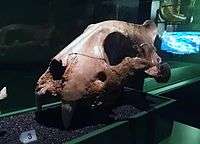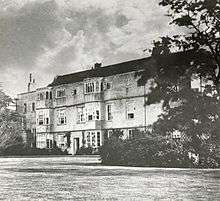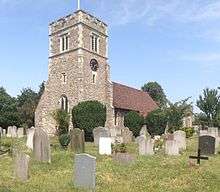Crayford
Crayford is a town and electoral ward located in Greater London, England within the London Borough of Bexley. It lies east of Bexleyheath and north west of Dartford. Crayford is in the historic county of Kent. The settlement developed by the river Cray, around a ford that is no longer used.
| Crayford | |
|---|---|
 | |
 Crayford Location within Greater London | |
| Population | 11,226 (2011 Census. Ward)[1] |
| OS grid reference | TQ515745 |
| • Charing Cross | 13.7 mi (22.0 km) WNW |
| London borough | |
| Ceremonial county | Greater London |
| Region | |
| Country | England |
| Sovereign state | United Kingdom |
| Post town | DARTFORD |
| Postcode district | DA1 |
| Dialling code | 01322 |
| Police | Metropolitan |
| Fire | London |
| Ambulance | London |
| UK Parliament | |
| London Assembly | |
History

An Iron Age settlement existed in the vicinity of the present St Paulinus Church between the Julian and Claudian invasions of Britain, from roughly 30 BC to AD 40. Roman ruins have been discovered and Crayford is one of several places proposed as the site of Noviomagus, a place mentioned in the Antonine Itinerary as being on the Roman equivalent of the later Watling Street. Crayford is also plausible as the site of the bloody battle of Crecganford ("Creeksford") in 457 in which Hengist defeated Vortimer to become the supreme sovereign of Kent.[2][3] The Anglo-Saxon Chronicle written around 400 years later describes how Hengist and Æsc defeated the "Brettas" at that battle.
Crayford is mentioned in the Domesday Book, which was compiled just prior to 1086, as a settlement within the Hundred of Litlelee with a church, three mills, and a relatively large population of 27 regular householders (villeins) and 2 smallholders. Its overlord was not a private individual or the king but Christ Church, Canterbury.[4]
As a (civil/combined) parish (before 1920) it included the hamlets of Northend, Perry Street and Slade Green which lie to the north. In 1831, the population of the parish was 2022 people.[5] For centuries it was strongly associated with brick-making, the printing of silk scarves, ties and calico cloths, and for a short period carpet-making.


There were two main Manor Houses in the area during the Middle Ages, Newbery Manor on the site of what is now Crayford Manor House, and Howbury Manor next to Slade Green. Roger Apylton had served Kings Henry V and Henry VI as auditor, and resided at Marshalls Court, Crayford. Late in the reign of Elizabeth I Henry Partich sold Newbery Manor to Henry Apylton of Marshalls Court, and Apylton built May Place close by.[6] Hall Place, which lies alongside the River Cray, was built for Lord Mayor of the City of London Sir John Champneis in around 1537. There was also an Iron Mill, which was later replaced by a saw mill (in 1765), which produced the timber for the floor of Buckingham Palace.[5] In 1551 Francis Goldsmith bought a 'Great tenement called The Place' next to the bridge in Crayford, and between 1556 and 1586 purchased substantial amounts of local farmland and the Old Bell Public House.[7]
In 1623 most of the parish of Crayford was purchased by Merchant Taylor Robert Draper[8] including Newbery Manor, Howbury Manor, Marshalls Court and May Place, where his family took up residence. Draper's wife Anne was the daughter of Thomas Harman who lived at Ellam House which subsequently passed to the Drapers.[9] The ownerships subsequently passed to Robert Draper's son William, who was selected to be the Sheriff of the County of Kent but died in 1650 before taking office, and then to Robert's grandson, parliamentarian Cresheld Draper. On the death of Cresheld Draper in 1694, his heirs sold all the properties to Sir Cloudesley Shovell'.[9]
Crayford Manor House was rebuilt in the eighteenth century, at the time essentially a farmhouse until it was remodelled in 1816 for the Rev. Thomas Barne. Historic England state it was built piecemeal over several periods, with a porch and Italianate features being added to the 1816 building.[10]
Other notable 19th-century local houses included Shenstone (built around 1828 and demolished 1974, the site is now Shenstone School, with Shenstone's former grounds now being Shenstone Park),[11] Stoneyhurst (which became Stoneyhurst Convent High School and is now the site of St Catherine's Roman Catholic School for Girls),[12][13] Martens Grove and Oakwood - the latter two designed by architect John Shaw, Jr. and built by George Locke of builders Locke & Nesham with each occupying one of the houses.[14]
Industrialisation
In 1819, the former saw mill site became a flour mill. Another major employer was the silk works set up by Augustus Applegath and later run by David Evans. The Maxim Nordenfeldt Gun and Ammunition Factory was also a major employer, until taken over by the Vickers Company in 1897. Vickers built military aeroplanes and armaments and became the dominant employer, building homes, a theatre and a canteen close to many workshops. The canteen (built during the First World War) became the town hall of the Crayford Urban District Council and remains a major landmark in municipal use.
Another former major employer in Crayford was Dussek Brothers (part of Burmah-Castrol since the 1960s) who operated their oils and waxes blending business on Thames Road from around 1928 until the site was bought by BP and subsequently closed down in 2001. The entire site was demolished in early 2010. The David Evans silk works is another recent closure, in 2002.
Demography
According to the 2011 census, 84% of the population is White British.[15]
Leisure
Crayford has a theatre and a greyhound racing track. The theatre was named in honour of Geoffrey Whitworth who played a key part in developing a British tradition of amateur drama and in building political support for The Royal National Theatre. The new Crayford Community Centre, located above the library, is the venue for many groups.[16]
Nearby Hall Place is a scheduled ancient monument lying between Crayford and Bexley. It has gardens with the River Cray running through and a plant nursery, a cafe and restaurant plus the silkworks shop.
"The Bear and Ragged Staff" public house are in the town centre.
The large Sainsbury's supermarket situated next to the greyhound stadium was claimed by Sainsbury's to be the world first's use of technology which heats the store using natural energy captured through boreholes buried hundreds of metres beneath the ground and was at the time of its expansion (2010) the largest Sainsbury's in England.[17]
The Tower Retail Park is opposite Crayford Town Hall.
The High Street is partly one-way for motor traffic.[18]
Sport
- VCD Athletic Football Club compete in the Isthmian League Premier Division ('VCD' stands for Vickers, Crayford and Dartford). They play at Oakwood stadium, on Old Road, Crayford, which they share with Kent Football United
- Crayford Arrows Sports Club[19] is a local football team, established in 1981
- Crayford Jujitsu Club[20] are a local self-defence martial art club, providing Jujitsu instruction to both adults (over 15 years of age) and children (from 6–14 years old). It was formerly located in the sports hall adjacent to the Crayford Greyhound Stadium, but was re-established at the Europa Centre, on Vimy Way in 2012 after being closed for a number of years
- Speedway racing was staged at Crayford Greyhound Stadium. The team raced in the inaugural 1968 British League Division Two as the Highwaymen before closing down. In later years the sport was revived and the team were known as the Kestrels. The track subsequently closed and the team moved to Hackney Stadium in East London
Education
- Secondary schools in the area include Haberdashers' Aske's Crayford Academy
Places of worship

Locality
Nearest places
- Bexleyheath
- Dartford
- Barnes Cray
- Slade Green
- Barnehurst
- Erith
- Bexley
Transport
Rail
Crayford railway station connects the town with Southeastern services to London Charing Cross via Sidcup, London Cannon Street via Sidcup and Lewisham, London Cannon Street via Woolwich Arsenal and Greenwich, Dartford and Gravesend.[23]
Buses
Crayford is served by three Transport for London bus services.
Notable residents
- Semi Ajayi[24]
- Augustus Applegath Inventor who built Shenstone House[25]
- Thomas Bevan soldier and played first-class cricket for the British Army cricket team.[26]
- Algernon Blackwood, Author, journalist and broadcaster lived in Crayford Manor House between 1871 and 1880.[10]
- William Claiborne, Surveyor of Jamestown in the Virginia Colony and established the first permanent European settlement in Maryland[27][28][29][30]
- George Green Footballer.[31]
- Thomas Harman, Author who resided in Crayford from 1547;[32]
- George Locke, Lived in Crayford was a builder of large buildings of note.[33]
- Nigeria under-20 international footballer
- Henry Nuttall Cricketer.[34]
- Keith and Gavin Peacock Father and son footballers.[35]
- Cloudesley Shovell, Admiral who lived at May Place between 1694 and 1707,[36]
- Frederick Currie, Lived at the Manor House, May Place.
- Hiram Maxim, Lived in Stoneyhurst from 1884 until 1889)[12][37]
- Derek Ufton, Played cricketfor Kent and football for Charlton Athletic.[38]
- Jack Wall, Inventor of the Crayford focuser[39]
References
- "Bexley Ward population 2011". Neighbourhood Statistics. Office for National Statistics. Retrieved 14 October 2016.
- Brayley, Edward Wedlake (1808). The Beauties of England and Wales; or, Original Delineations Topographical, Historical and Descriptive of Each Country. Vol.VII. London: Thomas Maiden Sherbourn-Lane. p. 550. Retrieved 9 March 2019.
- Schofield, John (1999). The Building of London: From the Conquest to the Great Fire (3 ed.). Sutton. p. 21. ISBN 0750921838. Retrieved 8 August 2018.
- Domesday Map Archived 20 February 2015 at the Wayback Machine Retrieved 2013-08-23
- 'Pigots 1840', on website freepages.genealogy.rootsweb.com/~shebra/pigots_1840 accessed 5 December 2007
- British History Online version of Hasted's History of Kent Volume 2 accessed 10 February 2016
- History of Parliament page on Francis Goldsmith accessed 10 February 2016
- History of Parliament article on Cresheld Draper accessed 10 February 2016
- Facets of Froyle website articles on the Draper family accessed 10 February 2016
- Historic England assessmengt of Crayford Manor House Archived 7 February 2016 at the Wayback Machine accessed 7 February 2016
- Parks & Gardens website page on Shenstone Park accessed 7 February 2016
- Dartford Council website article on Hiram Maxim Accessed 7 February 2016
- Bexley Boroughs Photos website text accompanying picture of Stoneyhurst Convent High School accessed 9 February 2016
- Bexley Council article on Martens and Oakwood Archived 15 February 2016 at the Wayback Machine accessed 7 February 2016
- Services, Good Stuff IT. "Crayford - UK Census Data 2011".
- Crayford Community Centre Your London Library; accessed 7 February 2016
- Sainsburys article on largest stores in England, Scotland and Wales Archived 3 March 2016 at the Wayback Machine J Sainsbury; accessed 7 February 2016
- Developer plans for new Crayford retail park Archived 7 February 2016 at the Wayback Machine Completely Retail
- "Crayford Arrows Sports Club: Football in the Community". Crayford Arrows FC. Archived from the original on 3 September 2006. Retrieved 26 October 2006.
- "Crayford Jujitsu Club". Europa Centre. Archived from the original on 4 May 2018. Retrieved 6 December 2018.
- "Acts2Church Crayford - A friendly, lively church in Crayford". Archived from the original on 6 November 2018. Retrieved 28 August 2019.
- "IDEAL HOMES:A HISTORY OF SOUTH-EAST LONDON SUBURBS". Retrieved 9 April 2019.
- Crayford National Rail Enquiries
- "Semi Ajayi". 11v11. Retrieved 1 December 2015.
- Bexley Council article 'Crayford' Archived 21 January 2016 at the Wayback Machine accessed 7 February 2016
- McCrery, Nigel (2011). The Coming Storm: Test and First-Class Cricketers Killed in World War Two. 2nd volume. Pen and Sword. p. 104-5. ISBN 1526706989.
- Clayburn Family website page about Thomas Claiborne Archived 26 June 2010 at the Wayback Machine accessed 10 February 2016
- Kent Island website history page Archived 4 March 2016 at the Wayback Machine accessed 10 February 2016
- Archives of Maryland biography of William Claiborne by Jennifer Copeland accessed 10 February 2016
- New Kent History Blog article on its establishment accessed 10 February 2016
- Chalk, Gary; Holley, Duncan; Bull, David (2013). All the Saints: A Complete Players' Who's Who of Southampton FC. Southampton: Hagiology Publishing. p. 78. ISBN 978-0-9926-8640-6.
- Rogues & Early Modern English Culture (University of Michigan Press, Craig Dionne & Steve Mentz, Editors ISBN 0-472-03177-5) page 106 shown at books.google.co.uk accessed 10 February 2016
- Littlehampton Fort website article about Locke & Nesham accessed 7 February 2016
- "Henry Nuttall". cricketarchive.com. Retrieved 25 November 2016.
- "Surnames beginning with P". London Borough of Bexley. Archived from the original on 20 December 2016. Retrieved 9 December 2016.
- CrayfordHistory website article about May Place Archived 27 August 2010 at the Wayback Machine accessed 7 February 2016
- Bexley Council website article on Hiram Maxim Archived 7 February 2016 at the Wayback Machine Accessed 7 February 2016
- 'A Remarkable Sporting Life' - article about Derek Ufton on Kent Cricket website accessed 10 February 2016
- Description of the Crayford Focuser Archived 10 October 2007 at the Wayback Machine accessed 28 November 2007
External links
- A description of Crayford in c. 1870 in the Imperial Gazetteer of England and Wales (from the 'Vision of Britain' website)
- Two maps of the area c.1800
- Maps of Crayford Parish in the past
- A diary listing musicians booked to appear at the Bear and Ragged Staff public house, 2 London Road
- North West Kent Family History Society - Crayford Parish Page
- Crayford Manor House Astronomical Society
- The brick-faced Town Hall, built as a canteen and offices for Vickers' staff and subsequently used for tea dances and other community events, now a clinic with flats above
- Summary of Vickers' mergers/acquisitions
- The Geoffrey Whitworth Theatre
- Crayford Tubes
